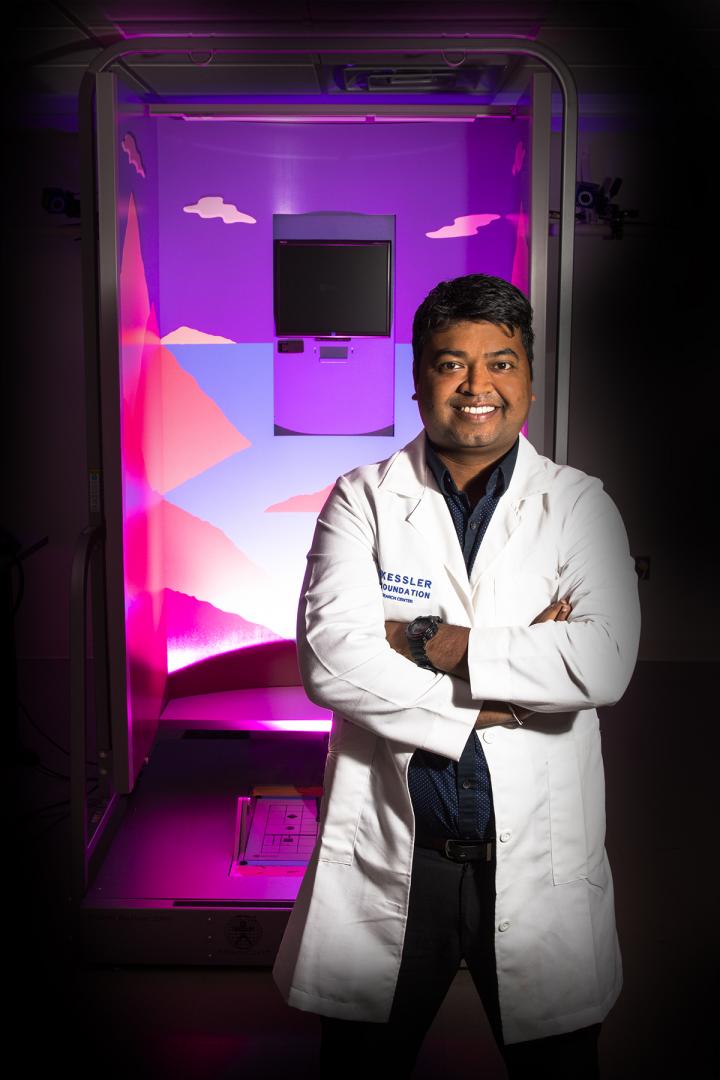Kessler Foundation team proposes comprehensive approach to integrating surface electromyography into clinical practice as path to improving rehabilitative care for individuals with spinal cord injury

Credit: Kessler Foundation
East Hanover, NJ. March 17, 2021. Kessler Foundation researchers have identified several practical and technical barriers to the widespread use of surface electromyography (sEMG) in clinical neurorehabilitation. Based on their holistic analysis of these factors, the researchers suggest a collaborative, interdisciplinary, and unified approach to enable rehabilitation professionals to routinely use sEMG. The article, “Use of Surface EMG in Clinical Rehabilitation of Individuals With SCI: Barriers and Future Considerations” (doi: 10.3389/fneur.2020.578559), was published December 18, 2020, in Frontiers in Neurology. It is available open access at https:/
The authors are Rakesh Pilkar, PhD, Kamyar Momeni, PhD, Arvind Ramanujam, Manikandan Ravi, Erica Garbarini, and Gail F. Forrest, PhD, affiliated with the Center for Mobility and Rehabilitation Engineering Research and the Tim and Caroline Reynolds Center for Spinal Stimulation at Kessler Foundation.
sEMG is a noninvasive technology that detects, records, and interprets the electrical activity of muscles. The quantifiable information on myoelectric output recorded by sEMG is extremely useful in assessing impairment and potentially determining patient-specific and effective interventions for individuals with spinal cord injury (SCI). However, while sEMG is commonly used in neurorehabilitation research, its integration into clinical practice has been limited, according to lead author Dr. Pilkar, senior research scientist at the Center for Mobility and Rehabilitation Engineering Research.
In their analysis, the research team determined several factors that prevent widespread use of sEMG in clinical practice. “One major obstacle is integrating the time-consuming aspects of sEMG into the already demanding schedule of physical therapists, occupational therapists, and other clinicians,” explained Dr. Pilkar. “Also, clinicians are often unfamiliar with technical aspects of sEMG data processing and may not have been exposed to or trained in certain aspects of this technology,” he added.
The research team also identified technical challenges such as transferring the frequent research updates to the sEMG systems used in a clinical setting; lack of user-friendly interfaces; and the need for a standardized, multidisciplinary approach to the handling and interpretation of data. An additional consideration, specific to research in SCI, is that reading and interpreting EMGs for this population requires an additional skillset, as the physiological and structural state of the spinal cord affect how data are interpreted.
To overcome these obstacles, Kessler researchers propose a series of actions to facilitate the use of sEMG by rehabilitation professions. First, including hands-on sEMG experience in educational and professional training programs, and exposing trainees to non-clinical experts in complementary fields such as engineers, technicians, and data scientists. Second, developing simpler, more user-friendly technology interfaces, as well as offering open-access user tutorials to make it easier for clinicians to integrate and use sEMG. Third, codifying a means to regularly transfer research-based knowledge about sEMG and its relevance to SCI rehabilitation from researchers to clinicians will empower rehabilitation professionals to use sEMG with more confidence.
“Addressing these barriers will improve our ability to objectively assess neuromuscular outcomes,” Dr. Pilkar predicted, “which is fundamental to developing interventions that improve motor function and mobility in individuals with deficits caused by SCI.”
###
Funding sources: New Jersey Commission on Spinal Cord Research (CSCR20ERG013, 314 CSCR14ERG007) and Kessler Foundation
About Kessler Foundation
Kessler Foundation, a major nonprofit organization in the field of disability, is a global leader in rehabilitation research that seeks to improve cognition, mobility and long-term outcomes, including employment, for people with neurological disabilities caused by diseases and injuries of the brain and spinal cord. Kessler Foundation leads the nation in funding innovative programs that expand opportunities for employment for people with disabilities. For more information, visit KesslerFoundation.org.
For more information, or to interview an expert, contact: Carolann Murphy, 973.324.8382, [email protected]
Media Contact
Carolann Murphy
[email protected]
Related Journal Article
http://dx.




